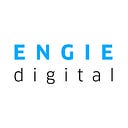Design system: a look back at a success story!
Created three years ago, the design system implemented by ENGIE Digital is now up and running for the ENGIE Group. Let us take a look back at its successful deployment with David de Vicente, Design System Lead at ENGIE Digital.
The design system is a Bible for designers and developers: it brings together a set of elements that make their jobs easier and ultimately improve the user experience with a website or any other digital product.
There is just one important question to ask yourself before you start creating a design system: “why?” If you cannot answer that question, you have caved into the pressure for every company to have its own design system.
Another key success factor is defining a target vision for this strategic tool. That means ensuring your design system is aligned with the shared goals of your company’s different departments: the employees responsible for communications, branding, technical elements, and design need to all have the same end goal.
Step-by-step adoption
At ENGIE, the creation of a design system three years ago was closely linked to the launch of the Group’s software company, ENGIE Digital, a year earlier. ENGIE Digital exists to accelerate the transition to a carbon-neutral future through unique software solutions that have a major impact on the world of today and tomorrow. With that aim in mind, the main goal of the design system was to provide a tool for harmonizing design and development practices. The first phase of the project was creating a library for designers to streamline processes and enhance collaboration.
But the question of the design system’s legitimacy quickly emerged: was the design system for ENGIE Digital or for the entire Group? A year after creating it, the design system team contacted the ENGIE brand management team to discuss the question and reach a decision. They started meeting monthly to discuss their respective projects and ENGIE Digital’s legitimacy to spearhead the design system was gradually acknowledged: the Group became a full-fledged user and customer for the “product”. Several global regions and countries, including North America, Chile, Romania, and Spain gradually adopted it, particularly for their corporate websites.
“Deploying a design system is a long process. You have to take it step-by step and be patient, simplify and explain what you are doing, and get people on board. And of course, it takes flexibility and an open mind, too. Instead of forcing people to use it, simply offer it alongside evidence of its effectiveness. People should adopt it because they believe in it, not because ENGIE requires it.”
David de Vicente, Design System Lead at ENGIE Digital
A real, permanent investment
Before taking the plunge, remember that a design system is a significant investment. To ensure it works well, you need to think in terms of the number of FTEs (Full Time Equivalents), not in numbers of employees who can contribute to the project in their spare time (design or development team members).
Since the design system was created, the number of FTEs involved has oscillated between two and five per year. The team working on the design system is currently made up of a PM lead, two developers, two designers, and one person tasked with communications. However, they are not all working on the project full time.
It is extremely important for the people leading the design system project to be good communicators. A design system is a “live” product that should be constantly in flux. That means constant exchanges between users and the people managing the system, who must respond to messages and keep the conversation going. In short, facilitating the community that grows up around the design system is key.
A design system also requires large volumes of documentation, which must be kept up to date. Users often treat them as manuals. They would be lost without them. And that also takes a lot of time…
To make things even more complicated, activity in a design system varies from month to month. There are intense production phases followed by steps when we process user requests and feedback, and of course correct bugs. Last but not least, there is a certain, incompressible amount of time required to onboard the agencies the company works with.
Conclusive results require indicators!
“ROI-focused indicators are decisive. We used them to assess the cost of a component to create, with and without the design system. We took the idea to the extreme: how long would the project take if we did it without the design system? Then we compared that number to how long the project actually took. The design system is a money saver, and we need to be able to measure those savings with precision.”
David de Vicente, Design System Lead at ENGIE Digital
Tracking use of a tool like a design system is a challenge. At ENGIE, the number of community members connected to the design system via Teams is tracked closely, as are the numbers of newsletter subscribers and Figma accounts. Thanks to Figma, the project team can identify the most frequently used components and see how often they are inserted into interfaces. We also use Google Analytics and Google Tag Manager to track the number of page views and the most visited sections on the ENGIE.design website.
Deploying a design system requires careful planning. Start by asking the right questions and do not rush as the project moves ahead. Design systems are launched step-by-step. It is a long process, one which entails winning over large numbers of stakeholders and obtaining key sponsorships. Communication and community management are key to the long-term legitimacy of a design system. They ensure that it does not lose momentum after the launch phase. All that adds up to one thing: the decision to create and launch a design system is a strategic business decision.
